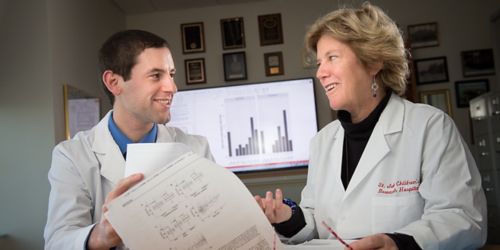St. Jude Family of Websites
Explore our cutting edge research, world-class patient care, career opportunities and more.
St. Jude Children's Research Hospital Home

- Fundraising
St. Jude Family of Websites
Explore our cutting edge research, world-class patient care, career opportunities and more.
St. Jude Children's Research Hospital Home

- Fundraising
Optimizing leukemia treatment through pharmaceutical science

Mary Relling, PharmD, right, studies how drugs used to treat pediatric cancer affect patients immediately and in the long-term. Recent work with Seth Karol, MD, left, have shed light on effectively treating cancer without causing unwanted side effects.
At St. Jude Children’s Research Hospital, we are working to make treatments more effective and less toxic—to do this, we have to understand how drugs behave in the body. There are several branches of research concerned with analyzing pharmaceuticals: pharmacokinetics describes what the body does to drugs, pharmacodynamics describes what drugs do to the body, and pharmacogenetics describes the genetic influences on drug effects among different patients.
Investigators at St. Jude are leaders in studying why some patients differ in their response to identical medications. As part of this effort, St. Jude was honored to host the 2019 Clinical Pharmacogenetics Implementation Consortium (CPIC) meeting June 6-7 in Memphis. CPIC, co-led by me and Dr. Teri Klein of Stanford University, is dedicated to removing barriers to the implementation of pharmacogenetic testing for clinical care.
Researchers at St. Jude, in my laboratory and others, are studying the pharmacodynamics of drugs used to treat pediatric cancer. In the U.S. today, existing treatments will help more than 90% of children with acute lymphoblastic leukemia (ALL) to survive. Asparaginase is an important part of ALL therapy. This chemotherapy drug is available in different formulations and is given in combination with other drugs. While asparaginase is a key medication for patients with ALL, it can be associated with side effects. To improve ALL therapy, investigators are St. Jude are studying the pharmacodynamics of asparaginase.
Limiting allergic reactions to asparaginase
The way that a drug is prepared, or formulated, can influence how the body responds to it. There are several formulations for asparaginase. Peg-asparaginase (PEG-ASP) is the current formulation used widely in the clinic because it lasts longer and is less likely to provoke problematic immune responses than previously used formations like native E. coli asparaginase (L-ASP). However, children treated with PEG-ASP can still experience an allergic reaction, interrupting care and requiring them to switch to a different formulation that needs more frequent administration, which can be a burden to patients and families.
PEG, or polyethylene glycol, is commonly added to protein-based drugs. There is increasing recognition that PEG itself can serve as an allergen, marshalling an immune response when it is unwanted. However, how PEG contributes to PEG-ASP reactions remain poorly understood, as do the risk factors for allergy to PEG-ASP. Recently published in the Journal of Clinical Oncology, our group studied the risk factors that may help differentiate who is likely to have an allergic reaction to PEG-ASP.
This study found that PEG itself can provoke the immune system into a reaction. We also found that the presence of antibodies against PEG-ASP could be useful for predicting and confirming clinical reactions to PEG-ASP. This information may help identify patients most likely in need of a different asparaginase formulation, and which patients may safely receive the drug again.
Understanding how to avoid treatment late-effects
When combined with the steroid dexamethasone for pediatric ALL treatment, asparaginase is also associated with osteonecrosis. Osteonecrosis, a condition where diminished blood flow causes bone to break down faster than the body makes it, can occur as a result of treatment for ALL. Current therapy for ALL includes giving dexamethasone on a discontinuous schedule, with more time in between treatments, to reduce the risk of osteonecrosis. This regimen is a standard part of ALL treatment.
In research published recently in the journal PLoS One, Seth Karol, MD, of the Department of Oncology, led our team to investigate the impact of this combination approach on both the efficacy of treatment and the risk of osteonecrosis. The results gave us the scientific evidence to support that with discontinuous dosing we’re on the right track clinically. Our study found that by giving dexamethasone on a discontinuous schedule, the combination has the same efficacy against pediatric ALL but does not increase the risk of osteonecrosis. This result confirms that discontinuous dosing is an important step towards maintaining the health of long-term survivors of childhood ALL.
Refining cancer treatments requires thinking about how drugs interact. As the field of ALL treatment continues to improve care, the approach to pharmacodynamics taken by St. Jude can help reveal more about these therapies. The laboratory systems in place for studying asparaginase, will serve as a starting point for further investigations into how this drug interacts in the body. Understanding how this drug behaves will aid efforts to maximize benefit while minimizing side-effects.






